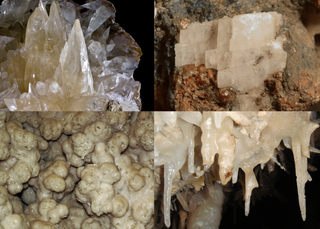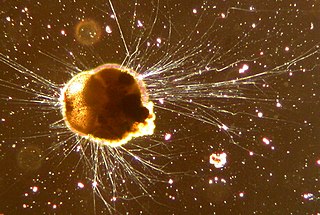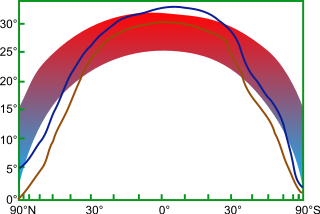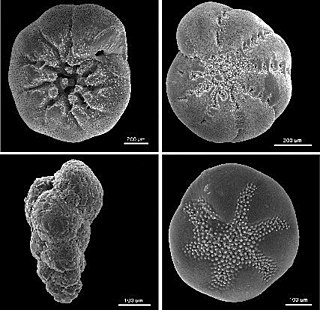
Limestone is a type of carbonate sedimentary rock which is the main source of the material lime. It is composed mostly of the minerals calcite and aragonite, which are different crystal forms of CaCO3. Limestone forms when these minerals precipitate out of water containing dissolved calcium. This can take place through both biological and nonbiological processes, though biological processes, such as the accumulation of corals and shells in the sea, have likely been more important for the last 540 million years. Limestone often contains fossils which provide scientists with information on ancient environments and on the evolution of life.

Calcite is a carbonate mineral and the most stable polymorph of calcium carbonate (CaCO3). It is a very common mineral, particularly as a component of limestone. Calcite defines hardness 3 on the Mohs scale of mineral hardness, based on scratch hardness comparison. Large calcite crystals are used in optical equipment, and limestone composed mostly of calcite has numerous uses.

Paleoclimatology is the scientific study of climates predating the invention of meteorological instruments, when no direct measurement data were available. As instrumental records only span a tiny part of Earth's history, the reconstruction of ancient climate is important to understand natural variation and the evolution of the current climate.

The Paleocene–Eocene thermal maximum (PETM), alternatively ”Eocene thermal maximum 1 (ETM1)“ and formerly known as the "Initial Eocene" or “Late Paleocene thermal maximum", was a geologically brief time interval characterized by a 5–8 °C global average temperature rise and massive input of carbon into the ocean and atmosphere. The event began, now formally codified, at the precise time boundary between the Paleocene and Eocene geological epochs. The exact age and duration of the PETM remain uncertain, but it occurred around 55.8 million years ago (Ma) and lasted about 200 thousand years (Ka).

Foraminifera are single-celled organisms, members of a phylum or class of Rhizarian protists characterized by streaming granular ectoplasm for catching food and other uses; and commonly an external shell of diverse forms and materials. Tests of chitin are believed to be the most primitive type. Most foraminifera are marine, the majority of which live on or within the seafloor sediment, while a smaller number float in the water column at various depths, which belong to the suborder Globigerinina. Fewer are known from freshwater or brackish conditions, and some very few (nonaquatic) soil species have been identified through molecular analysis of small subunit ribosomal DNA.

Carbonate rocks are a class of sedimentary rocks composed primarily of carbonate minerals. The two major types are limestone, which is composed of calcite or aragonite (different crystal forms of CaCO3), and dolomite rock (also known as dolostone), which is composed of dolomite (CaMg(CO3)2). They are usually classified on the basis of texture and grain size. Importantly, carbonate rocks can exist as metamorphic and igneous rocks, too. When recrystallized carbonate rocks are metamorphosed, marble is created. Rare igneous carbonate rocks even exist as intrusive carbonatites and, even rarer, there exists volcanic carbonate lava.
A paleothermometer is a methodology that provides an estimate of the ambient temperature at the time of formation of a natural material. Most paleothermometers are based on empirically-calibrated proxy relationships, such as the tree ring or TEX86 methods. Isotope methods, such as the δ18O method or the clumped-isotope method, are able to provide, at least in theory, direct measurements of temperature.

Oxygen isotope ratio cycles are cyclical variations in the ratio of the abundance of oxygen with an atomic mass of 18 to the abundance of oxygen with an atomic mass of 16 present in some substances, such as polar ice or calcite in ocean core samples, measured with the isotope fractionation. The ratio is linked to ancient ocean temperature which in turn reflects ancient climate. Cycles in the ratio mirror climate changes in the geological history of Earth.
Paleoceanography is the study of the history of the oceans in the geologic past with regard to circulation, chemistry, biology, geology and patterns of sedimentation and biological productivity. Paleoceanographic studies using environment models and different proxies enable the scientific community to assess the role of the oceanic processes in the global climate by the re-construction of past climate at various intervals. Paleoceanographic research is also intimately tied to paleoclimatology.
In geochemistry, paleoclimatology and paleoceanography δ18O or delta-O-18 is a measure of the deviation in ratio of stable isotopes oxygen-18 (18O) and oxygen-16 (16O). It is commonly used as a measure of the temperature of precipitation, as a measure of groundwater/mineral interactions, and as an indicator of processes that show isotopic fractionation, like methanogenesis. In paleosciences, 18O:16O data from corals, foraminifera and ice cores are used as a proxy for temperature.

Cholestane is a saturated tetracyclic triterpene. This 27-carbon biomarker is produced by diagenesis of cholesterol and is one of the most abundant biomarkers in the rock record. Presence of cholestane, its derivatives and related chemical compounds in environmental samples is commonly interpreted as an indicator of animal life and/or traces of O2, as animals are known for exclusively producing cholesterol, and thus has been used to draw evolutionary relationships between ancient organisms of unknown phylogenetic origin and modern metazoan taxa. Cholesterol is made in low abundance by other organisms (e.g., rhodophytes, land plants), but because these other organisms produce a variety of sterols it cannot be used as a conclusive indicator of any one taxon. It is often found in analysis of organic compounds in petroleum.

The cool tropics paradox is the apparent difference between modeled estimates of tropical temperatures during warm, ice-free periods of the Cretaceous and Eocene, and the colder temperatures which proxies suggested were present. The long-standing paradox was resolved when novel proxy derived temperatures showed significantly warmer tropics during past greenhouse climates. The low-gradient problem, i.e. the very warm polar regions with respect to present day, is still an issue for state-of-the-art climate models.

In geochemistry, paleoclimatology, and paleoceanography δ13C is an isotopic signature, a measure of the ratio of the two stable isotopes of carbon—13C and 12C—reported in parts per thousand. The measure is also widely used in archaeology for the reconstruction of past diets, particularly to see if marine foods or certain types of plants were consumed.
Professor Henry "Harry" Elderfield, was Professor of Ocean Chemistry and Palaeochemistry at the Godwin Laboratory in the Department of Earth Sciences at the University of Cambridge. He made his name in ocean chemistry and palaeochemistry, using trace metals and isotopes in biogenic carbonate as palaeochemical tracers, and studying the chemistry of modern and ancient oceans - especially those of the glacial epoch and the Cenozoic.
The Cenomanian-Turonian boundary event, also known as the Cenomanian-Turonian extinction, Cenomanian-Turonian Oceanic Anoxic Event, and referred to also as the Bonarelli Event or Level, was an anoxic extinction event in the Cretaceous period. The Cenomanian-Turonian oceanic anoxic event is considered to be the most recent truly global oceanic anoxic event in Earth's geologic history. There was a large carbon cycle disturbance during this time period, signified by a large positive carbon isotope excursion. However, apart from the carbon cycle disturbance, there were also large disturbances in the ocean's nitrogen, oxygen, phosphorus, sulphur, and iron cycles.
In geochemistry, hydrology, paleoclimatology and paleoceanography, δ15N or delta-N-15 is a measure of the ratio of the two stable isotopes of nitrogen, 15N:14N.
Vital effects are biological impacts on geochemical records. Many marine organisms, ranging from zooplankton to phytoplankton to reef builders, create shells or skeletons from chemical compounds dissolved in seawater. This process, which is also called biomineralization, therefore records the chemical signature of seawater during the time of shell formation. However, different species have different metabolism and physiology, causing them to create their shells in different ways. These biological distinctions cause species to record slightly different chemical signatures in their shells; these differences are known as vital effects.
Margaret (Peggy) Delaney is marine geochemist known for her research on trace elements to examine changes in ocean chemistry over time.

Foraminiferal tests are the tests of Foraminifera.
Global paleoclimate indicators are the proxies sensitive to global paleoclimatic environment changes. They are mostly derived from marine sediments. Paleoclimate indicators derived from terrestrial sediments, on the other hand, are commonly influenced by local tectonic movements and paleogeographic variations. Factors governing the Earth's climate system include plate tectonics, which controls the configuration of continents, the interplay between the atmosphere and the ocean, and the Earth's orbital characteristics. Global paleoclimate indicators are established based on the information extracted from the analyses of geologic materials, including biological, geochemical and mineralogical data preserved in marine sediments. Indicators are generally grouped into three categories; paleontological, geochemical and lithological.
















